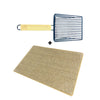Which Type of Small Animal Bedding is Best for Your Hamster or Gerbil?

Choosing the best bedding for your hamster or gerbil is a crucial aspect of pet care, impacting their health, comfort, and happiness. With a multitude of options available, it can be challenging to determine which type will best suit your furry friend’s needs. Each bedding type comes with its own set of benefits and drawbacks, and the right choice often depends on your pet’s specific preferences and behaviors.
We’ve dived deep into the most popular bedding types, focusing on safety, comfort, and practicality. Our goal is to provide you with a comprehensive guide to help you make an informed decision about your small animal's bedding. This overview will highlight the key features of various bedding options and point out potential issues to watch for, ensuring your hamster or gerbil has the perfect environment to thrive.
Hamsters and gerbils love to burrow. Without the opportunity to do so and get some energy out, these little furballs might start chewing on their cage. A bedding that accommodates burrowing is a must. You’ll need about 15–20” of bedding for an excellent burrow. This will also help entertain these furry friends.
|
Option |
Pros |
Cons |
|
Wood* (including Aspen and Douglas Fir |
· Safe · Sustainable · Low dust · Great odor control |
· Can stick to long fur |
|
Paper |
· Soft and comfortable · Widely available · Absorbent · Sustainable
|
· If paper contains inks or scents, it may be toxic to your pet · Hard to burrow |
|
Hemp bedding |
· Excellent for tunneling/burrowing · Absorbent · Sustainable · Low dust · Naturally antibacterial and antimicrobial |
· Can be difficult to find in stores as it’s a seasonal crop · Expensive |
|
Hay |
· Allows chewing if soft |
· Sharp hay can harm small animals |
|
Bedding to Avoid |
· Cedar, which has phenols and other toxins · Scented wood shavings, which can stress a hamster or gerbil’s respiratory tract and ingestion can cause liver or kidney disease · Anything bedding that is scented or synthetic ·Corncob, which molds easily when wet and can cause intestinal blockages if ingested · Cat-specific litter, particularly any with tiny pellets or heavy scents, which can irritate your small animal or could be eaten and cause blockages
|
|
*Ensure any wood bedding is phenol-free. If phenols are present, they can irritate the skin and respiratory system of your small pet and cause issues for humans, too. Wood that is kiln-dried should be phenol free.
Of course, just like humans, your small animals have innate preferences. Even if you’ve done your homework and chosen what you believe is the perfect bedding for your pet, they might have other ideas. Your furry friend will continue to show its personality, and you can keep trying until you find the best option for your little pal!
How much bedding do you need?
Below are Catalyst’s recommendations for the amount of bedding each type of small animal needs. Of course, use your own judgment as you get to know your pet’s preferences!
|
Small Animal |
Gerbil or Hamster |
Chinchilla or Ferrett |
Guinea Pig |
Rabbit |
Rat or Mouse |
|
Habitat Size |
23” x 19” |
25” x 25” |
48” x 24” |
54” x 27” |
20” x 14” |
|
Bedding Depth |
4” – 6” |
2” – 3” |
2” – 3” |
2” – 3” |
2” – 3” |
|
Amount Needed |
43L |
35L |
57L |
72L |
20L |













